Transient Liquid Phase Diffusion Bonding of Ni3Al Superalloy with Low-Boron Nickel-Base Powder Interlayer
Abstract
1. Introduction
2. Materials and Methods
2.1. Material Preparation
2.2. Transient Liquid Phase Diffusion Bonding
2.3. Characterization Methods
3. Results and Discussion
3.1. The Microstructure of Ni3Al TLP-Diffusion-Bonded Joints Using Low-B Interlayer
3.2. The Phases of Ni3Al TLP-Diffusion-Bonded Joints Using Low-B Interlayer
3.3. The Mechanical Properties of Ni3Al TLP-Diffusion-Bonded Joints Using Low-B Interlayer
3.4. The Fracture Morphology of Ni3Al TLP-Diffusion-Bonded Joints Using Low-B Interlayer
4. Conclusions
Author Contributions
Funding
Institutional Review Board Statement
Informed Consent Statement
Data Availability Statement
Conflicts of Interest
References
- Panwisawas, C.; Tang, Y.B.T.; Reed, R.C. Metal 3D printing as a disruptive technology for superalloys. Nat. Commun. 2020, 11, 2327. [Google Scholar] [CrossRef]
- Fan, Y.S.; Yang, X.G.; Shi, D.Q.; Tan, L.; Huang, W.Q. Quantitative mapping of service process-microstructural degradation-property deterioration for a Ni-based superalloy based on chord length distribution imaging process. Mater. Des. 2021, 203, 109561. [Google Scholar] [CrossRef]
- Liu, H.; Xu, M.M.; Li, S.; Bao, Z.B.; Zhu, S.L.; Wang, F.H. Improving cyclic oxidation resistance of Ni3Al based single crystal superalloy with low diffusion platinum modified aluminide coating. J. Mater. Sci. Technol. 2020, 54, 132–143. [Google Scholar] [CrossRef]
- Smith, T.M.; Esser, B.D.; Antolin, N.; Carlsson, A.; Williams, R.E.A.; Wessman, A.; Hanlon, T.; Fraser, H.L.; Windl, W.; McComb, D.W.; et al. Phase transformation strengthening of high-temperature superalloys. Nat. Commun. 2016, 7, 134134. [Google Scholar] [CrossRef]
- Chang, C.; Jiang, L.W.; Wu, M.L.; Li, S.S.; Han, Y.F. Effect of temperature and stress on high temperature creep behavior of Ni3Al-based single crystal superalloy. Prog. Nat. Sci. Mater. 2022, 32, 267–271. [Google Scholar] [CrossRef]
- Yuan, L.; Xiong, J.T.; Peng, Y.; Shi, J.M.; Li, J.L. Microstructure and mechanical properties in the solid-state diffusion bonding joints of Ni3Al based superalloy. Mater. Sci. Eng. A 2020, 772, 138670. [Google Scholar] [CrossRef]
- Sun, W.J.; Wang, S.L.; Xin, J.J.; Chen, Y.H.; Pang, Y.; Jia, Y.L. Optimizing for IC10 single crystal Ni3Al-based alloy joint by electron beam welding with chemical composition controlling. Mater. Des. 2020, 196, 109172. [Google Scholar] [CrossRef]
- Chai, H.Z.; Wang, L.L.; Lin, X.; Zhang, S.Y.; Yang, H.O.; Huang, W.D. Microstructure and cracking behavior of Ni3Al-based IC21 alloy fabricated by selective laser melting. Mater. Charact. 2023, 196, 112592. [Google Scholar] [CrossRef]
- Li, C.; Si, X.; Bian, S.; Dong, Z.; Huang, Y.; Qi, J.; Feng, J.; Cao, J. Diffusion bonding of Ti and Zr at ultra-low temperature via surface nano-crystallization treatment. Mater. Sci. Eng. A 2020, 785, 139413. [Google Scholar] [CrossRef]
- Bakhtiari, R.; Ekrami, A. Transient liquid phase bonding of FSX-414 superalloy at the standard heat treatment condition. Mater. Charact. 2012, 66, 38–45. [Google Scholar] [CrossRef]
- Yue, X.; Liu, F.M.; Li, Q.; Qin, H.B.; Gao, H.T.; Li, L.K.; Yi, Y. Effect of post-bond heat treatment on microstructure and mechanical properties of the wide gap TLP bonded IC10 superalloy with a low boron Ni3Al-based interlayer. J. Manuf. Process. 2020, 54, 109–119. [Google Scholar] [CrossRef]
- Kim, J.K.; Park, H.J.; Shim, D.N.; Kim, D.J. Effect of bonding parameters on microstructural characteristics during TLP bonding of directionally solidified Ni-based superalloy. J. Manuf. Process. 2017, 30, 208–216. [Google Scholar] [CrossRef]
- Zhang, L.X.; Chang, Q.; Sun, Z.; Xue, Q.; Feng, J.C. Effects of boron and silicon on microstructural evolution and mechanical properties of transient liquid phase bonded GH3039/IC10 joints. J. Manuf. Process. 2019, 38, 167–173. [Google Scholar] [CrossRef]
- Pouranvari, M.; Ekrami, A.; Kokabi, A.H. Effect of bonding temperature on microstructure development during TLP bonding of a nickel base superalloy. J. Alloys Compd. 2009, 469, 270–275. [Google Scholar] [CrossRef]
- Amiri, D.; Sajjadi, S.A.; Bakhtiari, R.; Kamyabi-Gol, A. The role of TLP process variables in improvement of microstructure and mechanical properties in TLP joints of GTD-111/Ni-Cr-Fe-B-Si/GTD-111 system. J. Manuf. Process. 2018, 32, 644–655. [Google Scholar] [CrossRef]
- Jiao, Y.J.; Sheng, G.M.; Zhang, Y.T.; Xu, C.; Yuan, X.J. Transient liquid phase bonding of Inconel 625 with Mar-M247 superalloy using Ni-Cr-B interlayer: Microstructure and mechanical properties. Mater. Sci. Eng. A 2022, 831, 142204. [Google Scholar] [CrossRef]
- Cheng, Z.; Li, X.Q.; Wang, B.; Qu, S.G.; Li, H.Y. M3B2-type borides effect on the wide gap brazing of K417G alloy with mixed powder. J. Alloys Compd. 2020, 821, 153431. [Google Scholar] [CrossRef]
- Yang, Z.; Sun, K.; Lian, J.; Cai, X.; Wang, Y.; Wang, D.; Liu, Y. Interfacial microstructure evolution and mechanical properties of Ni3Al-based alloy TLP joints with BNi-2 interlayer. Intermetallics 2020, 125, 106885. [Google Scholar] [CrossRef]
- Peng, Y.Y.; Li, C.; Li, H.J.; Liu, Y.C. Effect of interlayer on microstructure and mechanical properties of diffusional-bonded Ni3Al-based superalloy/S31042 steel joint. J. Manuf. Process. 2021, 72, 252–261. [Google Scholar] [CrossRef]
- Zhang, L.X.; Sun, Z.; Xue, Q.; Lei, M.; Tian, X.Y. Transient liquid phase bonding of IC10 single crystal with GH3039 superalloy using BNi2 interlayer: Microstructure and mechanical properties. Mater. Des. 2016, 90, 949–957. [Google Scholar] [CrossRef]
- Yang, Y.H.; Xie, Y.J.; Wang, M.S.; Ye, W. Microstructure and tensile properties of nickel-based superalloy K417G bonded using transient liquid-phase infiltration. Mater. Des. 2013, 51, 141–147. [Google Scholar] [CrossRef]
- Pouranvari, M.; Ekrami, A.; Kokabi, A.H. TLP bonding of cast IN718 nickel based superalloy: Process-microstructure-strength characteristics. Mater. Sci. Eng. A 2013, 568, 76–82. [Google Scholar] [CrossRef]
- Chai, L.; Huang, J.H.; Hou, J.B.; Lang, B.; Wang, L. Effect of Holding Time on Microstructure and Properties of Transient Liquid-Phase-Bonded Joints of a Single Crystal Alloy. J. Mater. Eng. Perform. 2015, 24, 2287–2293. [Google Scholar] [CrossRef]
- Yang, Z.W.; Lian, J.; Wang, J.; Cai, X.Q.; Wang, Y.; Wang, D.P.; Wang, Z.M.; Liu, Y.C. Diffusion bonding of Ni3Al-based alloy using a Ni interlayer. J. Alloys Compd. 2020, 819, 153324. [Google Scholar] [CrossRef]
- Peng, Y.; Li, J.L.; Peng, X.; Li, S.W.; Xiong, J.T.; Shi, J.M. Interfacial microstructure evolution and formation process of the joints prepared by diffusion bonding on DD6 nickel-based single crystal superalloy. J. Mater. Res. Technol. 2020, 9, 16317–16328. [Google Scholar] [CrossRef]
- Yuan, L.; Ren, J.; Xiong, J.T.; Zhao, W.; Shi, J.M.; Li, J.L. Transient liquid phase bonding of Ni3Al based superalloy using Mn-Ni-Cr filler. J. Mater. Res. Technol. 2021, 11, 1583–1593. [Google Scholar] [CrossRef]
- Philips, N.R.; Levi, C.G.; Evans, A.G. Mechanisms of microstructure evolution in an austenitic stainless steel bond generated using a quaternary braze alloy. Metall. Mater. Trans. A 2008, 39, 142–149. [Google Scholar] [CrossRef]
- Pouranvari, M.; Ekrami, A.; Kokabi, A.H. Solidification and solid state phenomena during TLP bonding of IN718 superalloy using Ni-Si-B ternary filler alloy. J. Alloys Compd. 2013, 563, 143–149. [Google Scholar] [CrossRef]
- Tazikeh, H.; Mirsalehi, S.E.; Shamsipur, A. Relationship of isothermal solidification completion and precipitate formation with mechanical properties of Inconel 939 joints vacuum TLP bonded by an amorphous Ni-Cr-Fe-Si-B filler alloy. J. Mater. Res. Technol. 2022, 18, 4762–4774. [Google Scholar] [CrossRef]
- Malekan, A.; Farvizi, M.; Mirsalehi, S.E.; Saito, N.; Nakashima, K. Effect of bonding temperature on the microstructure and mechanical properties of Hastelloy X superalloy joints bonded with a Ni-Cr-B-Si-Fe interlayer. J. Manuf. Process. 2019, 47, 129–140. [Google Scholar] [CrossRef]
- Otsuka, K.; Ren, X. Physical metallurgy of Ti-Ni-based shape memory alloys. Prog. Mater. Sci. 2005, 50, 511–678. [Google Scholar] [CrossRef]
- Bakhtiari, R.; Ekrami, A.; Khan, T.I. The effect of TLP bonding temperature on microstructural and mechanical property of joints made using FSX-414 superalloy. Mater. Sci. Eng. A 2012, 546, 291–300. [Google Scholar] [CrossRef]
- He, Y.; Zheng, W.; Yang, J.; Zhu, D.; Yang, X.; Gao, Z. An analysis of high-temperature microstructural stability and mechanical performance of the Hastelloy N-Hastelloy N Superalloy joint bonded with pure Ti. Mater. Des. 2018, 144, 72–85. [Google Scholar] [CrossRef]
- Kakitani, R.; Reyes, R.V.; Garcia, A.; Spinelli, J.E.; Cheung, N. Relationship between spacing of eutectic colonies and tensile properties of transient directionally solidified Al-Ni eutectic alloy. J. Alloys Compd. 2018, 733, 59–68. [Google Scholar] [CrossRef]
- Zhu, C.X.; Yu, T.; Wang, C.Y.; Wang, D.W. First-principles study of Ni/Ni3Al interface doped with Re, Ta and W. Comput. Mater. Sci. 2020, 175, 109586. [Google Scholar] [CrossRef]
- Moniruzzaman, M.; Fukaya, H.; Murata, Y.; Tanaka, K.; Inui, H. Diffusion of Al and Al-Substituting Elements in Ni3Al at Elevated Temperatures. Mater. Trans. 2012, 53, 2111–2118. [Google Scholar] [CrossRef]
- Gao, Q.; Jiang, Y.; Liu, Z.; Zhang, H.; Jiang, C.; Zhang, X.; Li, H. Effects of alloying elements on microstructure and mechanical properties of Co-Ni-Al-Ti superalloy. Mater. Sci. Eng. A 2020, 779, 139139. [Google Scholar] [CrossRef]
- Stacy, J.P.; Zhang, Y.; Pint, B.A.; Haynes, J.A.; Hazel, B.T.; Nagaraj, B.A. Synthesis and oxidation performance of Al-enriched gamma + gamma ‘ coatings on Ni-based superalloys via secondary aluminizing. Surf. Coat. Technol. 2007, 202, 632–636. [Google Scholar] [CrossRef]
- Coakley, J.; Ma, D.; Frost, M.; Dye, D.; Seidman, D.N.; Dunand, D.C.; Stone, H.J. Lattice strain evolution and load partitioning during creep of a Ni-based superalloy single crystal with rafted gamma’ microstructure. Acta Mater. 2017, 135, 77–87. [Google Scholar] [CrossRef]
- Lu, N.; Lei, Z.; Hu, K.; Yu, X.; Li, P.; Bi, J.; Wu, S.; Chen, Y. Hot cracking behavior and mechanism of a third-generation Ni-based single-crystal superalloy during directed energy deposition. Addit. Manuf. 2020, 34, 101228. [Google Scholar] [CrossRef]
- Zhang, Z.B.; Yang, Z.B.; Lu, S.; Harte, A.; Morana, R.; Preuss, M. Strain localisation and failure at twin-boundary complexions in nickel-based superalloys. Nat. Commun. 2020, 11, 4890. [Google Scholar] [CrossRef] [PubMed]
- Bergsmo, A.; Xu, Y.L.; Poole, B.; Dunne, F.P.E. Twin boundary fatigue crack nucleation in a polycrystalline Nickel superalloy containing non-metallic inclusions. J. Mech. Phys. Solids 2022, 160, 104785. [Google Scholar] [CrossRef]
- Yeratapally, S.R.; Glavicic, M.G.; Hardy, M.; Sangid, M.D. Microstructure based fatigue life prediction framework for polycrystalline nickel-base superalloys with emphasis on the role played by twin boundaries in crack initiation. Acta Mater. 2016, 107, 152–167. [Google Scholar] [CrossRef]
- Stinville, J.C.; Vanderesse, N.; Bridier, F.; Bocher, P.; Pollock, T.M. High resolution mapping of strain localization near twin boundaries in a nickel-based superalloy. Acta Mater. 2015, 98, 29–42. [Google Scholar] [CrossRef]
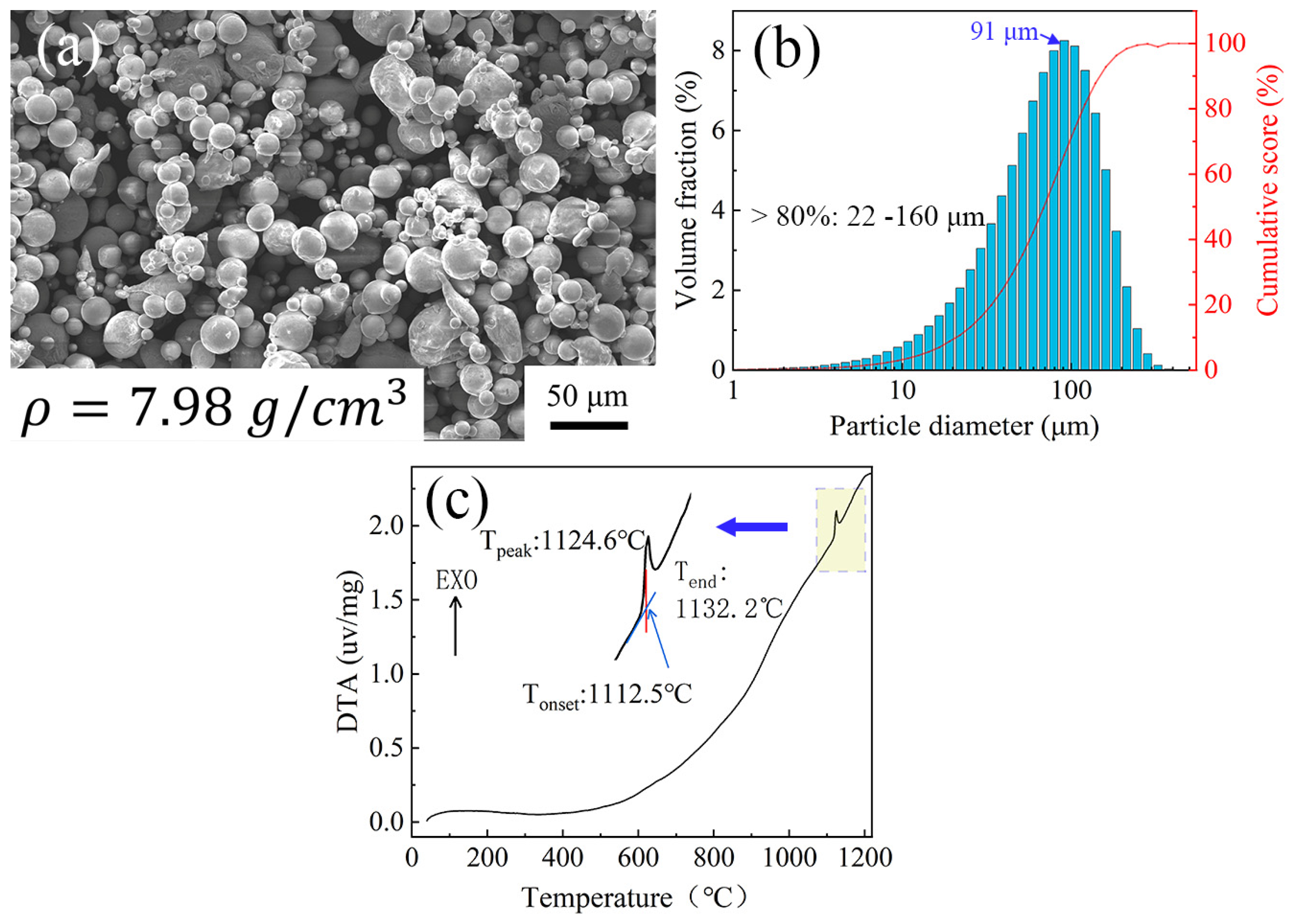


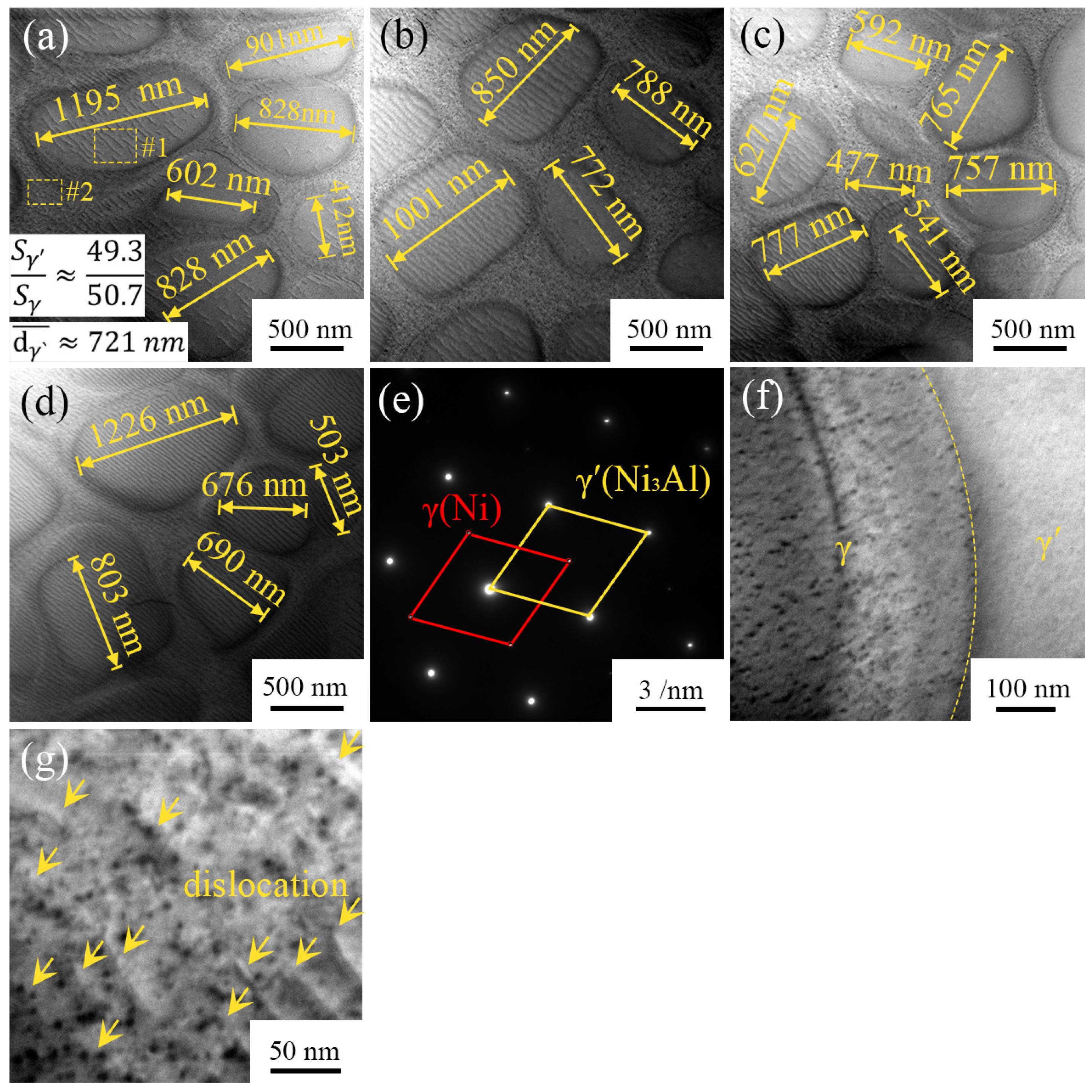
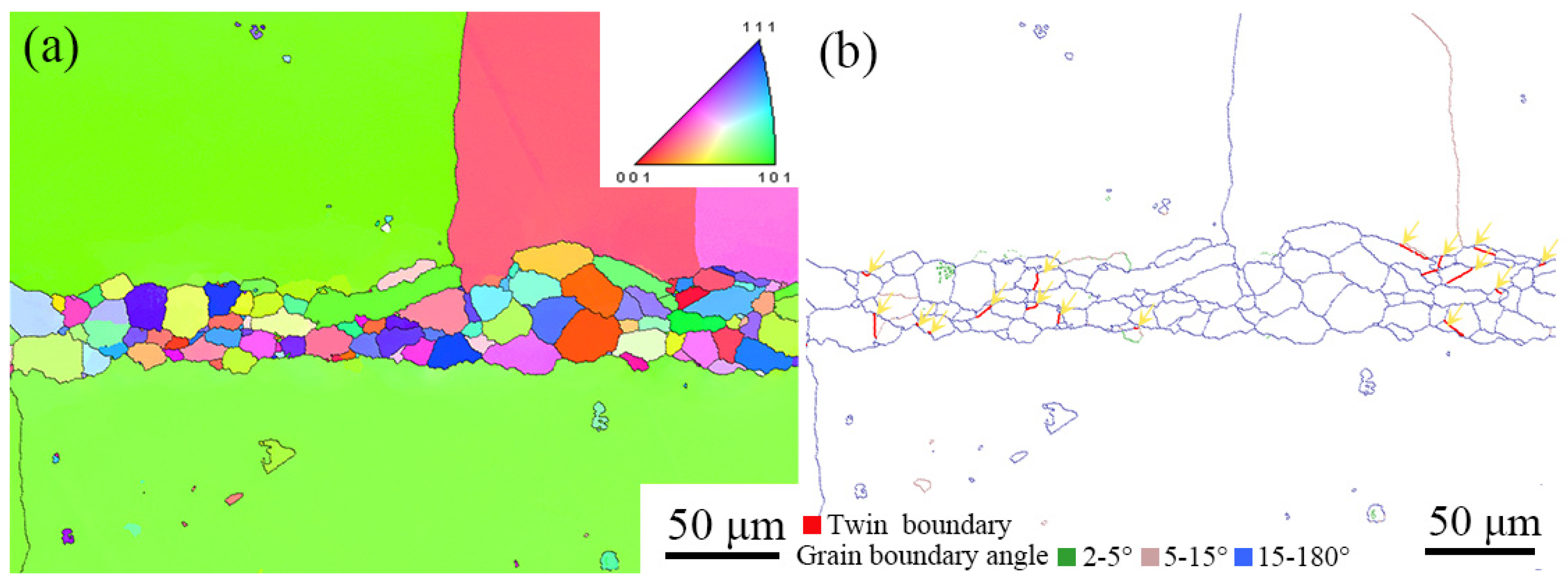

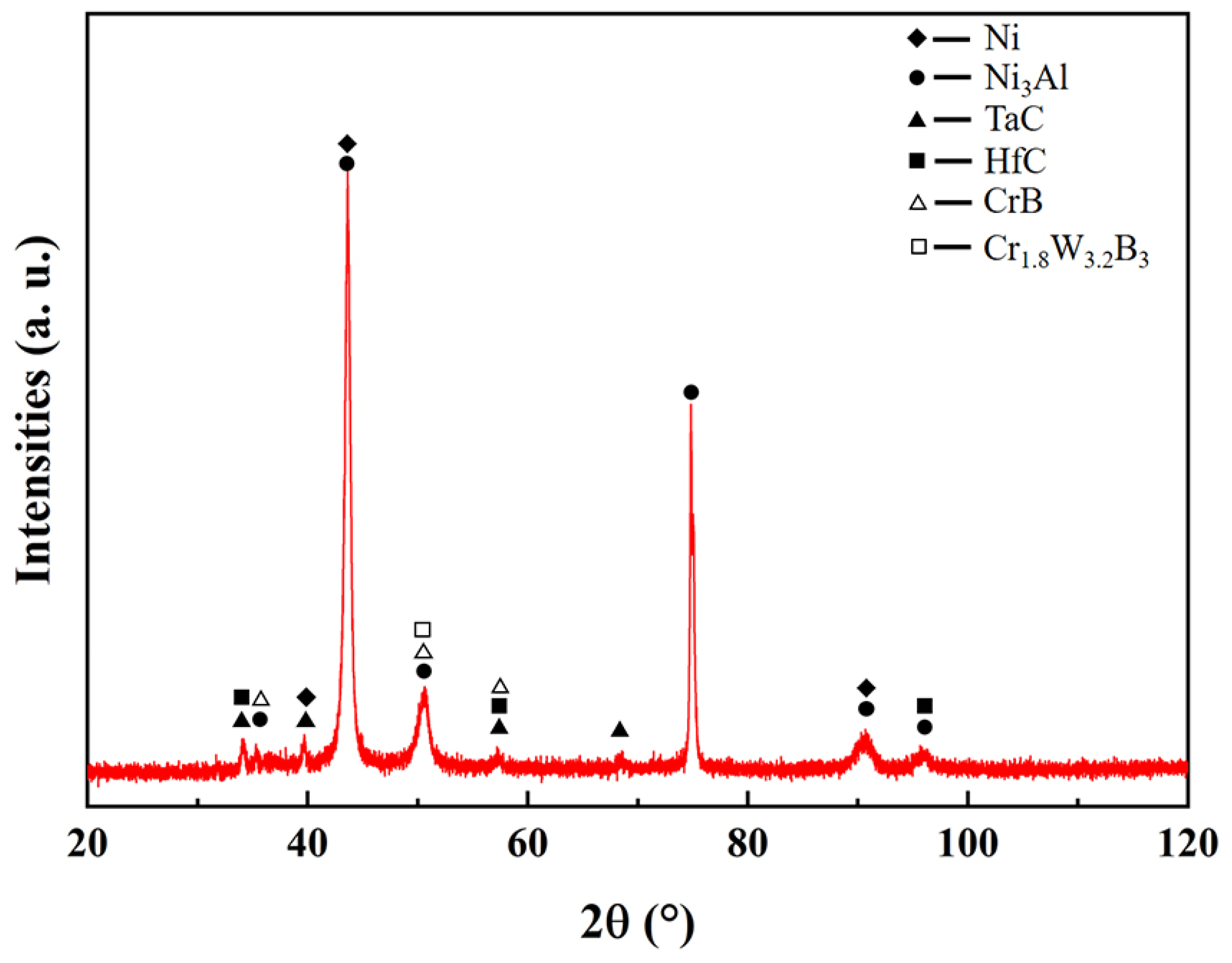
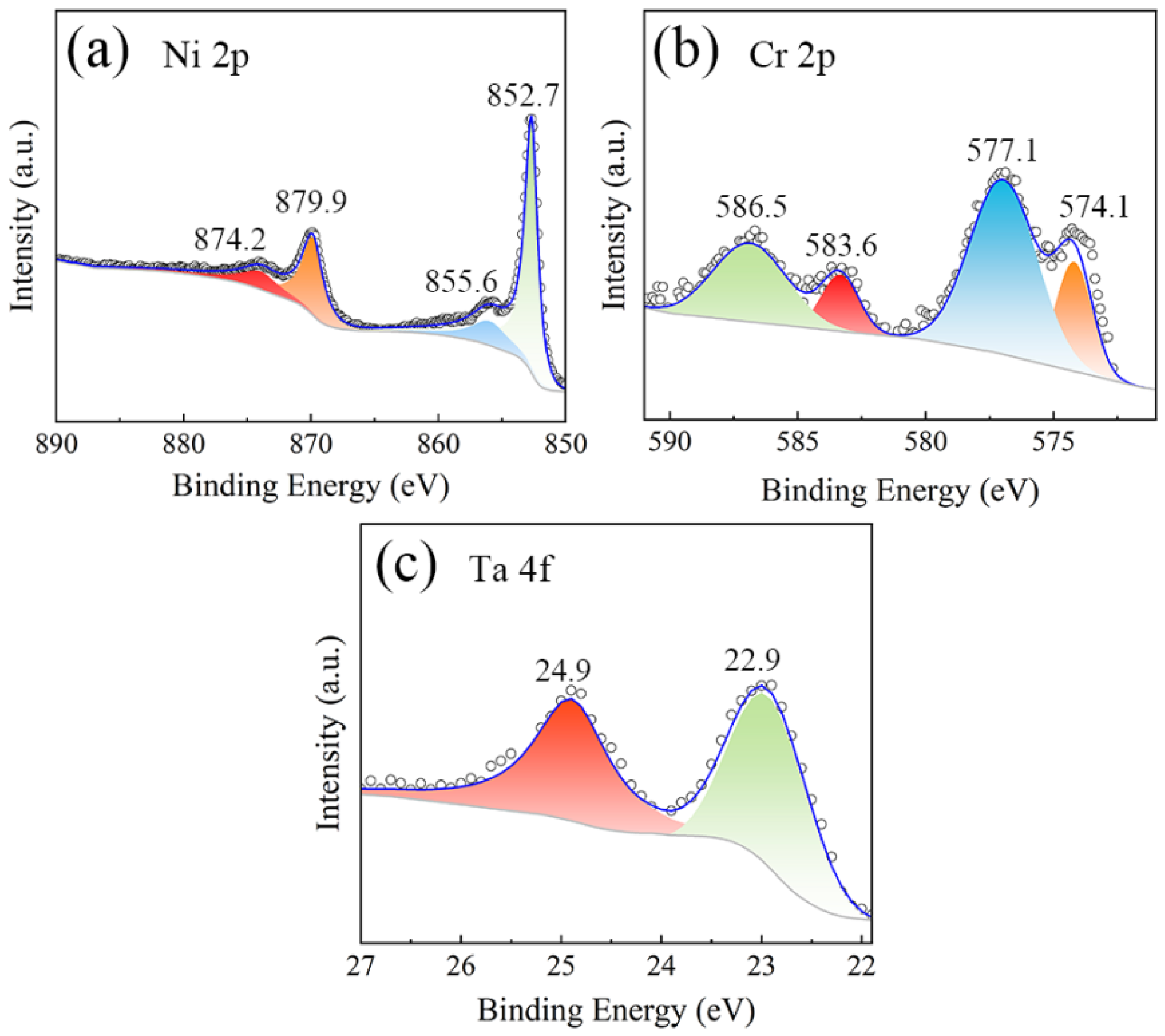
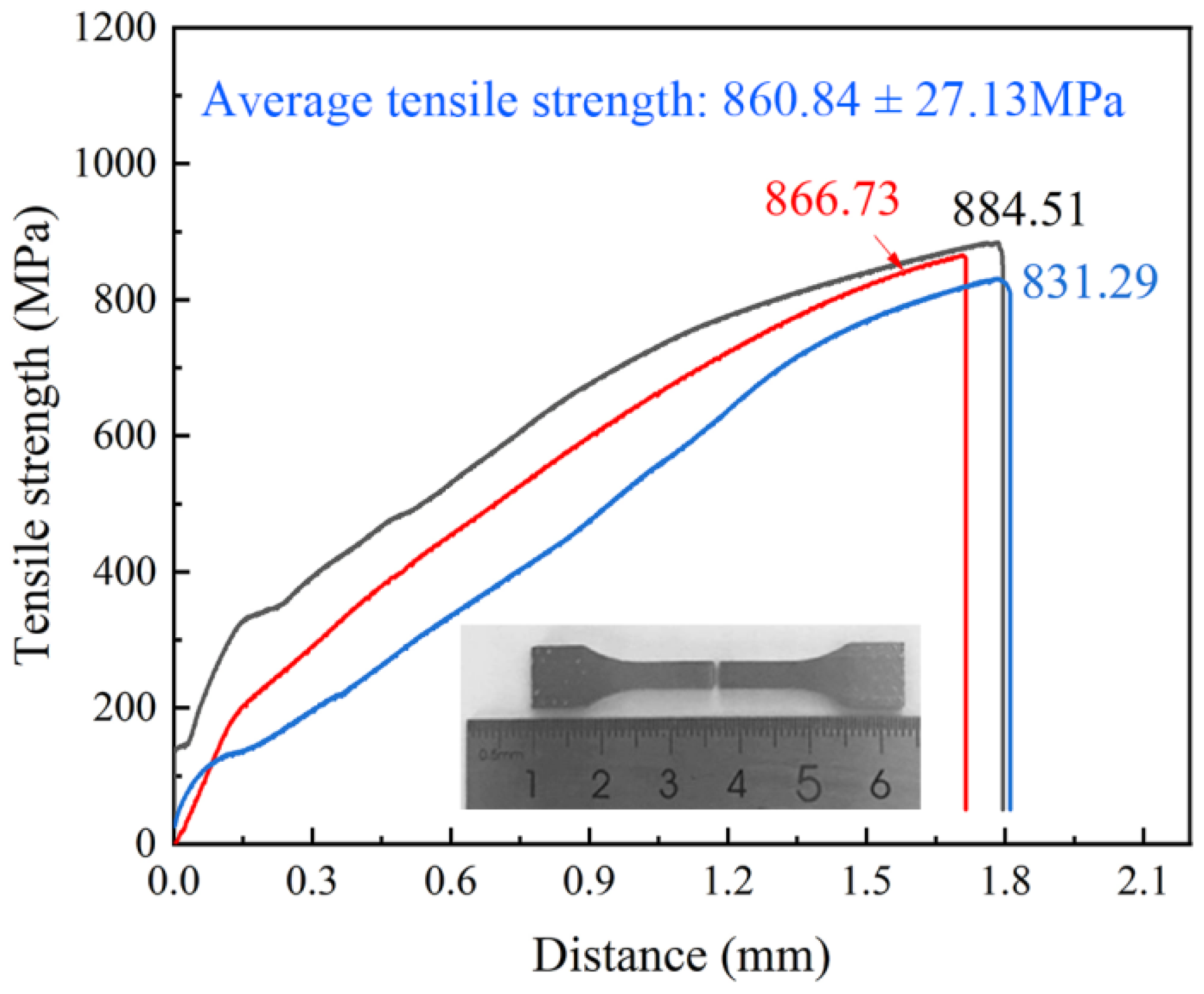
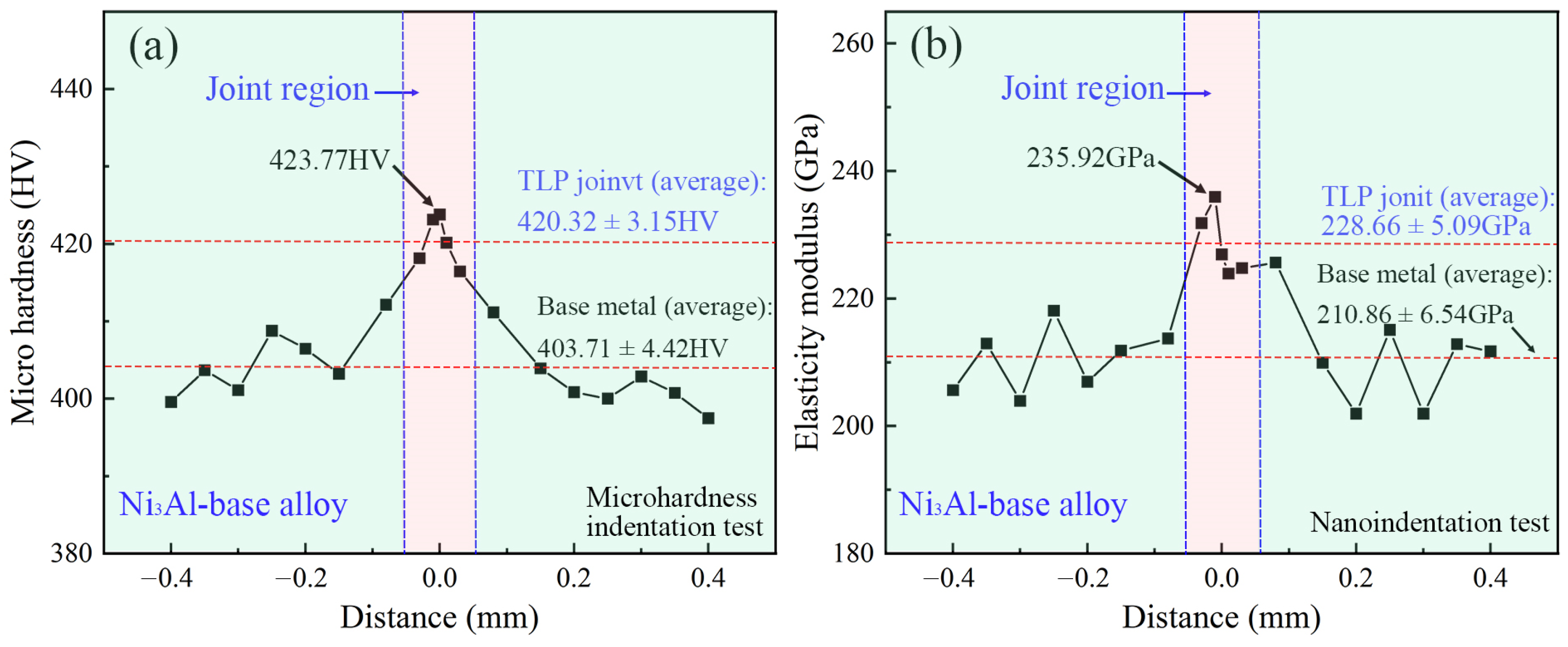
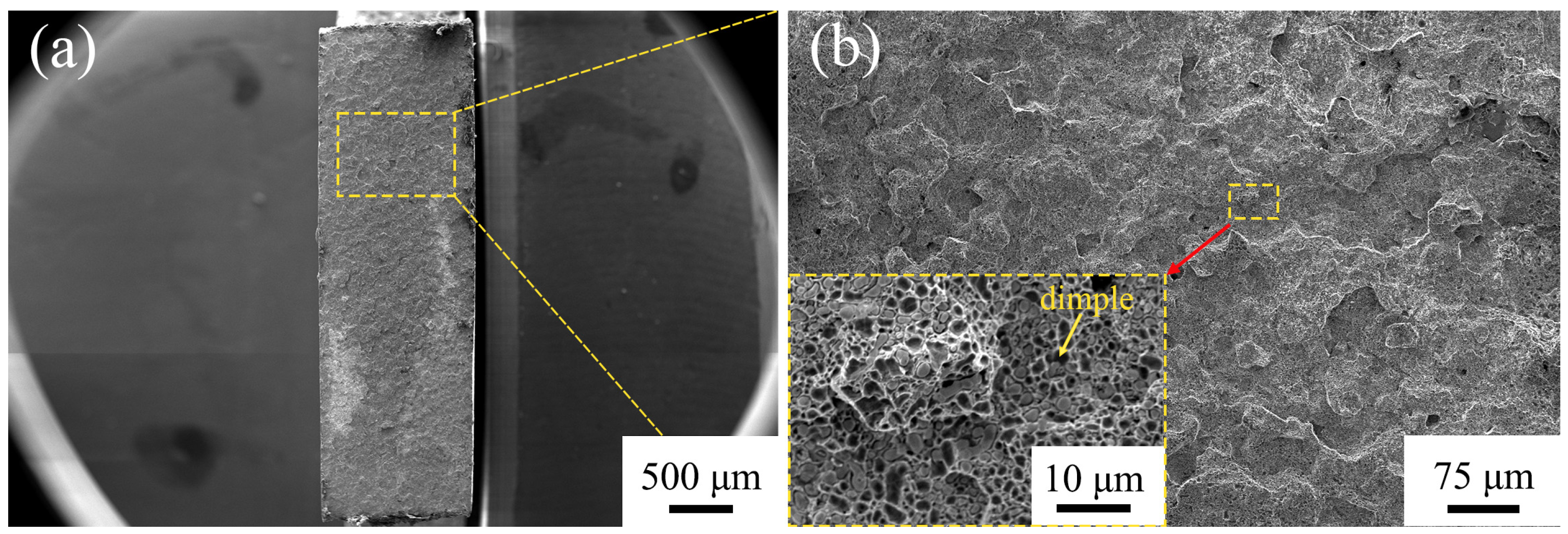
| Materials | Co | Cr | Ta | Al | W | Hf | Mo | Ti | Nb | Re | B | C | Ni |
|---|---|---|---|---|---|---|---|---|---|---|---|---|---|
| Interlayer | 7.37 | 12.61 | 3.75 | 3.20 | 4.64 | - | 0.96 | 4.51 | 0.35 | 2.45 | 1.27 | 1.37 | Bal |
| Ni3Al- base alloy | 12.15 | 6.94 | 6.87 | 6.02 | 4.81 | 1.63 | 1.22 | - | - | - | - | 1.21 | Bal |
| Position | C | Al | Ti | Cr | Co | Ni | Mo | Hf | Ta | W |
|---|---|---|---|---|---|---|---|---|---|---|
| #1 | 21.25 | - | 0.27 | 7.07 | 11.51 | 31.73 | 0.47 | 24.76 | 2.94 | - |
| #2 | 3.84 | 3.15 | - | 22.10 | 2.99 | 14.57 | - | - | 2.12 | 51.23 |
| #3 | 6.29 | 11.45 | 0.38 | 4.98 | 8.51 | 64.58 | 0.31 | 0.24 | 1.65 | 1.61 |
| #4 | 6.34 | 2.81 | - | 11.54 | 13.64 | 64.33 | - | - | - | 1.34 |
| Area | C | Al | Ti | Cr | Co | Ni | Mo | Hf | Ta | W |
|---|---|---|---|---|---|---|---|---|---|---|
| #1 | 4.13 | 12.17 | 0.11 | 3.73 | 8.74 | 66.16 | 1.03 | - | 1.56 | 1.37 |
| #2 | 3.58 | 3.99 | 0.06 | 14.42 | 15.39 | 61.19 | 0.34 | - | - | 1.03 |
Disclaimer/Publisher’s Note: The statements, opinions and data contained in all publications are solely those of the individual author(s) and contributor(s) and not of MDPI and/or the editor(s). MDPI and/or the editor(s) disclaim responsibility for any injury to people or property resulting from any ideas, methods, instructions or products referred to in the content. |
© 2023 by the authors. Licensee MDPI, Basel, Switzerland. This article is an open access article distributed under the terms and conditions of the Creative Commons Attribution (CC BY) license (https://creativecommons.org/licenses/by/4.0/).
Share and Cite
Wen, Z.; Li, Q.; Liu, F.; Dong, Y.; Zhang, Y.; Hu, W.; Li, L.; Gao, H. Transient Liquid Phase Diffusion Bonding of Ni3Al Superalloy with Low-Boron Nickel-Base Powder Interlayer. Materials 2023, 16, 2554. https://doi.org/10.3390/ma16072554
Wen Z, Li Q, Liu F, Dong Y, Zhang Y, Hu W, Li L, Gao H. Transient Liquid Phase Diffusion Bonding of Ni3Al Superalloy with Low-Boron Nickel-Base Powder Interlayer. Materials. 2023; 16(7):2554. https://doi.org/10.3390/ma16072554
Chicago/Turabian StyleWen, Zhifeng, Qi Li, Fengmei Liu, Yong Dong, Yupeng Zhang, Wei Hu, Likun Li, and Haitao Gao. 2023. "Transient Liquid Phase Diffusion Bonding of Ni3Al Superalloy with Low-Boron Nickel-Base Powder Interlayer" Materials 16, no. 7: 2554. https://doi.org/10.3390/ma16072554
APA StyleWen, Z., Li, Q., Liu, F., Dong, Y., Zhang, Y., Hu, W., Li, L., & Gao, H. (2023). Transient Liquid Phase Diffusion Bonding of Ni3Al Superalloy with Low-Boron Nickel-Base Powder Interlayer. Materials, 16(7), 2554. https://doi.org/10.3390/ma16072554







